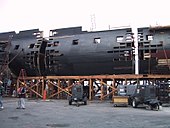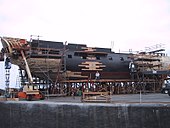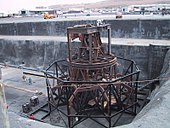Baja Studios
| Fox Baja Studios | |
| Founded | 1996 |
| Headquarters | Rosarito, Baja California, Mexico |
Area served | Worldwide |
| Products | Filming Studios, filming stages, filming tanks, productions, major filming studios, movie productions, box office |
| Website | www.bajafilmstudios.com |
Baja Studios, formerly Fox Baja, is an American-owned film studio near the resort community of Rosarito, Baja California, Mexico. It comprises the world's largest stages and water tanks designed for filming.[1] As well as major film work the facility is used for making commercials, music videos, television series, and movies for television.
Originally built for Twentieth Century Fox for the reconstruction of RMS Titanic in the 1997 film Titanic, it has since then built some of the largest sets for numerous other studios including, MGM's Tomorrow Never Dies, Amblin Entertainment's In Dreams, Warner Bros.'s Deep Blue Sea, Phoenix Pictures's Weight of Water, Disney's Pearl Harbor and Fox's Master and Commander: The Far Side of the World. The studios are near Rosarito, Baja California, Mexico.
History[]
Fox Baja Studios began life as a subsidiary of Twentieth Century Fox, a part of the global corporate holdings of Rupert Murdoch on land leased by the Hollywood studio. Construction of the facility costing an estimated $20 million USD[2] began on 6 June 1996 on land leased by the Hollywood studio next to the northern edge of a small fishing village (Puerto Popotla). The corporation had an interest in breaking the power in Hollywood of the Teamsters Union,[3] the corporation had learned from the Wapping dispute. The studios design was heavily influenced by the production needs of the first film to be shot there; James Cameron's epic Titanic, where there was a requirement to shoot a 775 foot long replica of the ship in a water tank.[4] Fox sold the Studios in May 2007 to Baja Acquisitions (a consortium of "local financial interests") for an eight-figure US Dollar sum.[5]
There was a downturn in the area from 2007 when tourism lessened due to a local drug war and a tightening of travel restrictions. Popotla had become attractive to smugglers of illegal immigrants at night once the restaurant trade had closed for the day.[6]
In 2018 a resurgence in film making for net streaming by Amazon, HBO, and Netflix lifted prospects for the studio.[7]
Facilities[]

The studio is built alongside the ocean coastline, enabling an unobstructed view of the sea. It comprises 51 acres of land overlooking the Pacific Ocean, with 2,000 feet of coastline frontage. The facility has 5 stages and 4 indoor and outdoor water tanks, street sets, and is a self-contained facility, with offices, scenery shops, wardrobe and dressing rooms. Two of the stages and three of the tanks are combined. There are four tanks of a combined volume of over 20 million gallons fed by a filtration sea water plant capable of delivering 9,000 gallons of water per minute.
Tank 1 is an infinite horizon pond which adjoins and overlooks the Pacific, it is a 360,000 square foot concrete pool with a full capacity of 17 million gallons, used for exterior shooting, wet or dry, and consists of three depth levels between 3 1/2 to 40 feet. The tank can be emptied or filled in 40 hours. Alongside is a 162-foot motor driven tower crane, used for constructing film sets, and as a lighting and camera platform. There is a smaller outdoor tank and another two built into an indoor stage. The tank was built to film Titanic. Fox employed majorly American technical personnel, despite available Mexican resources. On completion of filming the tank was drained of chlorinated water too quickly without management in one batch ruining the fishing waters at Popotla.[8]
Studio tour[]
Fox created a Studio Tour named Foxploration, which opened in May 2001 consisting largely of Titanic exhibits, Fox derived displays, and items from other films notably Master and Commander.[9] This tour closed.
Props for Master and Commander: The Far Side of the World[]

Full size fake Tank Ship under construction

Full size fake Tank Ship under construction

Gimbal machine in the deepest part of tank 1
Films[]
- Titanic (1997)
- Tomorrow Never Dies (1998) (Second Unit)
- Deep Blue Sea (1999)
- In Dreams (1999)
- The Weight of Water (2000)
- Pearl Harbor (2001)
- Master and Commander: The Far Side of the World (2003)
- Kung Pow! Enter the Fist (2002)
- Ghosts of the Abyss (2003)
- Jumper (2008)
- All Is Lost (2013)
- Against the Sun (2014)
- Little Boy (2015)
Television[]
- Tremors (2003)
- Fear the Walking Dead (2016) • Season 2
- 9-1-1 (TV series) (2019) Season 3
- Selena: The Series (2020–2021) • Part 1 and Part 2
Other projects[]
U2 rehearsals for the Vertigo Tour
References[]
- ^ "Baja Film Studios Official Site". bajafilmstudios.com. Retrieved 24 December 2017.
- ^ Herzog, Lawrence A. (2000). Competing Globally Through The Tourism Industry: A San Diego-Baja California Perspective (PDF). School of Public Administration and Urban Studies San Diego State University. p. 18. Retrieved 19 January 2018.
- ^ Judd, Dennis R. (2002). The Infrastructure of Play: Building the Tourist City (1 ed.). Cities and Contemporary Society. p. 237. ISBN 076560955X.
- ^ Corey, Melinda (2002). The American Film Institute desk reference. A Stonesong Press book. p. 67. ISBN 0789489341. Retrieved 11 January 2018.
- ^ Muttalib, Bashirah (21 May 2007). "Variety". Retrieved 10 January 2018.
- ^ Berestein, Leslie (1 March 2010). "Baja village has become smugglers' launch point (2010)". The San Diego Tribune. Retrieved 16 January 2018.
- ^ Vincent, Roger (16 December 2017). "Resurgence in film making for streaming 2017". LA Times. Retrieved 3 February 2018.
- ^ Hart, John Mason (11 April 2002). Empire and Revolution: The Americans in Mexico since the Civil War. University of California Press. p. 495. ISBN 0520223241. Retrieved 19 January 2018.
- ^ "Studio Tour". thestudiotour.com. Retrieved 24 December 2017.
External links[]
| Wikimedia Commons has media related to Baja Studios. |
- 1996 establishments in Mexico
- Film production companies of Mexico
- Cinema of Mexico
- Entertainment companies established in 1996
- Mass media companies established in 1996
- Companies based in Mexico City


